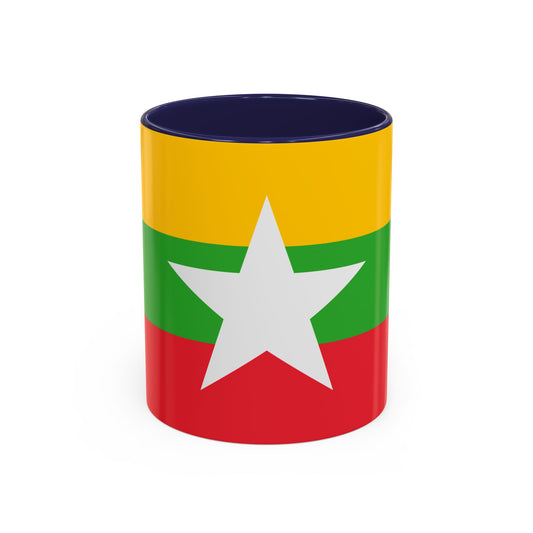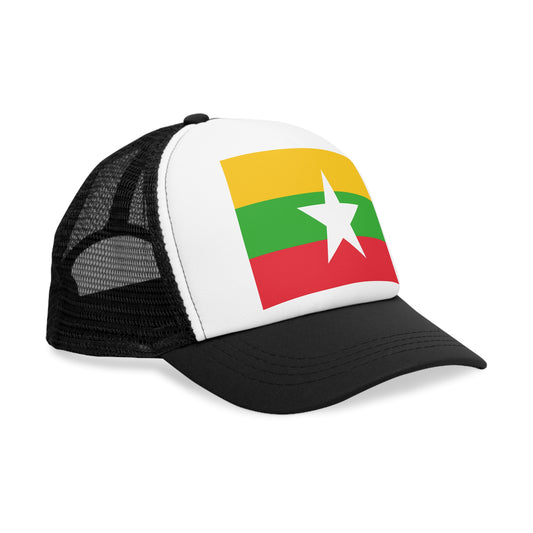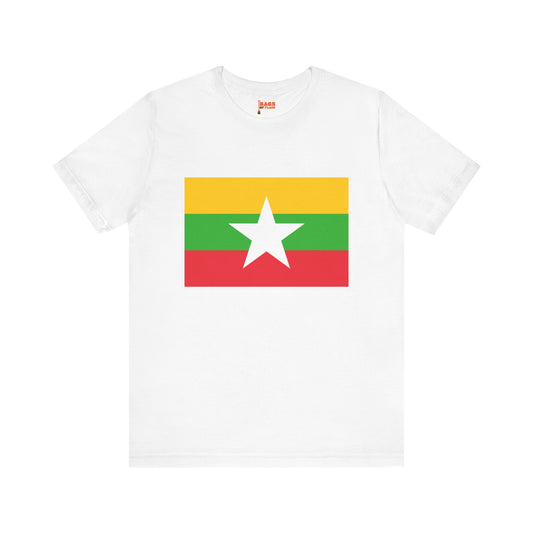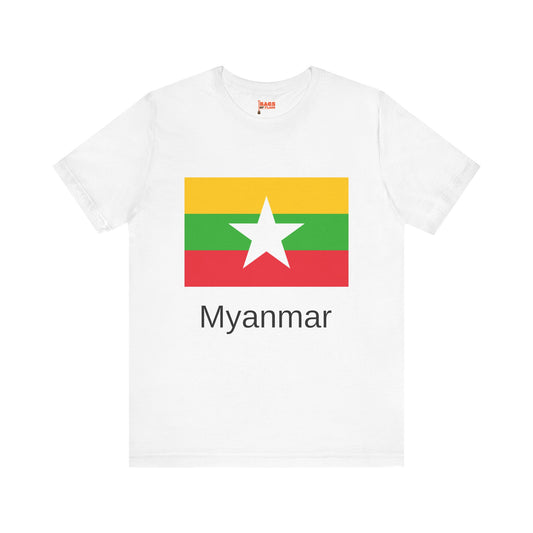-
Myanmar Sweatshirt
Regular price $34.15 USDRegular priceUnit price / per -
Myanmar Flag Sweatshirt
Regular price $34.15 USDRegular priceUnit price / per -
Myanmar Pillow
Regular price $22.65 USDRegular priceUnit price / per -
Myanmar Backpack
Regular price $59.79 USDRegular priceUnit price / per -
Myanmar Leather Patch Hat
Regular price $18.85 USDRegular priceUnit price / per -
Myanmar Mug
Regular price $11.65 USDRegular priceUnit price / per -
Myanmar Trucker Cap
Regular price $14.90 USDRegular priceUnit price / per -
Myanmar Flag on T-shirt
Regular price $22.79 USDRegular priceUnit price / per -
Myanmar Flag Hoodies
Regular price $34.40 USDRegular priceUnit price / per -
Myanmar T-shirts
Regular price $22.79 USDRegular priceUnit price / per -
Myanmar Hoodies
Regular price $34.40 USDRegular priceUnit price / per
Collection: Myanmar / Burma
The Myanmar flag, also known as the Burma flag, is a symbol of national pride and identity for the people of Myanmar. With its unique design and colors, the flag holds historical significance and is an essential emblem for the country. We will explore lesser-known facts about the Myanmar flag, including its design, historical context, symbolism, current relevance, and unique protocols.
Overview of the Myanmar Flag

The national emblem of Myanmar consists of a striking flag with three horizontal stripes in vibrant yellow, green, and red, crowned by a conspicuous white star centered at the top. This flag not only stands out visually but is also loaded with meaning. The topmost stripe of yellow symbolizes the solidarity among the diverse groups within the country. In contrast, the middle green stripe evokes the peace and tranquility of Myanmar's lush landscapes and the hope for a harmonious future.
The red stripe at the bottom reflects the courage and determination of the Myanmar people, a testament to their resilience in the face of adversity. At the heart of the flag, the white star radiates against the colorful backdrop, symbolizing the purity of the union and the collective hope for progress and prosperity. This emblem is more than just a flag; it is a vibrant tapestry of the nation's values, struggles, and aspirations, woven into a symbol deeply embedded in the heart of Myanmar's identity.
Historical Context of the Myanmar Flag

The evolution of the Myanmar flag is closely tied to the country’s tumultuous political landscape. Initially adopted in 1974, the flag signified the establishment of the Burmese socialist republic, underlining the radical change in governance and national ideology. This marked a departure from previous flags, which reflected the colonial legacy and the struggle for independence. The design has undergone modifications throughout the years, reflecting shifts in the political climate and governance ideologies.
The most recent update occurred in 2010, coinciding with the introduction of a new constitution and the government's attempts to present a united national front amidst ongoing internal conflicts and moving towards a more open economy. These changes in the flag mirror Myanmar's journey through colonial rule, independence, internal conflict, and attempts at national reconciliation and unity. The adaptations are not just alterations in design but signify more profound political shifts and the aspirations of the Myanmar people at different historical junctures.
Symbolism Behind the Myanmar Flag
Each element of the Myanmar flag is imbued with rich meaning that transcends its aesthetic appeal. The trio of horizontal stripes - yellow, green, and red - are not arbitrarily chosen colors but are deeply symbolic representations of the country's core values and aspirations. The yellow stripe at the top symbolizes the unity that binds Myanmar's diverse ethnicities and communities, highlighting the collective identity that overshadows individual differences. Below the yellow, the green stripe paints a picture of the country's verdant landscapes, a nod to the peace and tranquility the nation strives to achieve amidst its tumultuous history. It symbolizes the hope for a future where harmony prevails over conflict. The red stripe anchors the flag, symbolizing the courage and determination of the Myanmar people. This color speaks to the resilience and bravery central to the nation's narrative, from its struggle for independence to its ongoing journey toward democracy and freedom.
Center stage on this colorful backdrop is a large, white, five-pointed star. This star is a beacon of light representing the purity of the union and the collective ambition for progress and prosperity. It underscores the importance of unity and solidarity in reaching national goals, reminding citizens and observers alike of the enduring strength and hope that defines Myanmar.
Current Relevance of the Myanmar Flag
Today, the Myanmar flag remains a pivotal symbol of national pride and solidarity. It is prominently featured at various significant events such as Independence Day celebrations, cultural festivals, and other state ceremonies, where it fosters a sense of unity and national identity among the citizens. The flag also plays a critical role in military events, serving as a testament to the bravery and resilience of the armed forces and the nation. Despite its widespread use and importance, the flag has not been without its controversies. It has been central to political discourse, reflecting the ongoing debates and tensions within Myanmar's evolving political landscape. Discussions around the flag often mirror broader conversations about identity, governance, and the country's future direction. In this light, the Myanmar flag continues to be a living symbol, representing not only the nation's heritage and values but also its people's current struggles and aspirations.
Additional Facts and Protocols for the Myanmar Flag
In Myanmar, the flag commands a high level of respect, governed by a set of established protocols that underscore its importance as a national symbol. When displayed, the flag should always occupy a position of prominence. It should be flown higher than other nearby flags to highlight its superior status. Additionally, when the flag is raised or lowered, it must be done ceremoniously to honor its significance.
A crucial aspect of flag etiquette is ensuring that the flag never touches the ground, a principle that safeguards its dignity. To preserve its sanctity and meaning, misuse of the flag, such as employing it for commercial purposes or altering its design, is strictly prohibited.
When the flag is displayed alongside other national symbols or flags from different countries, careful attention is paid to its placement and the relative sizes of the flags to maintain respect for each nation’s emblem while emphasizing Myanmar’s sovereignty.
Handling the flag with care is paramount; when folded, it should be done in a manner that respects its symbolic value. These protocols are not merely formalities but are imbued with deep respect for the flag’s role as a symbol of the nation’s identity, unity, and aspirations. Following these guidelines ensures the flag’s esteemed position in the hearts and minds of the Myanmar people is preserved.






















